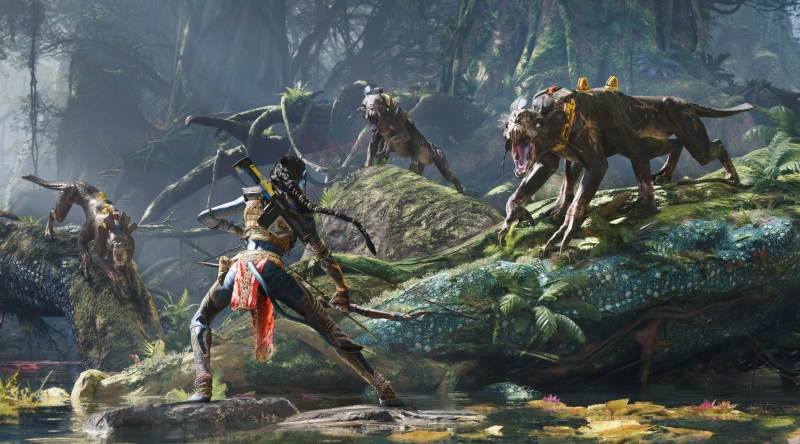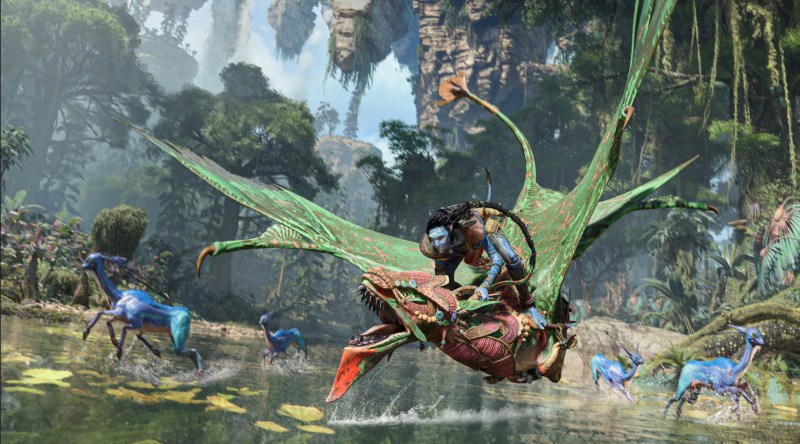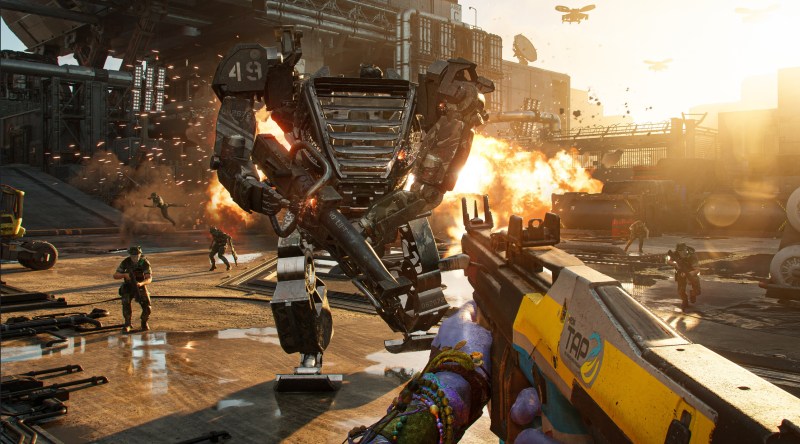When Ubisoft announced that it was making an Avatar game, I admit to it wasn’t necessarily top of my list of games to play. I wasn’t a fan of the films (don’t love them, don’t hate them) and the game looked kind of generic in the teaser trailers. But when it came closer to release, I admit I changed my mind. I had great faith in developers Massive Entertainment after all they’ve done with The Division, and if anyone can make an open-world exploration game, it’s Ubisoft.
Also, Avatar: Frontiers of Pandora was coming out at the perfect time. Any earlier in the year and it would have been drowned out by the deluge of more exciting games, but early December is the perfect time for a by-the-numbers Ubisoft sandbox title. As I was mentally worn out from the more complex titles 2023 has thrown at me, I was ready to love Frontiers of Pandora.
Now, after having played it, I have one thing to say:
I fucking give up.
What in the Ubisoft support phone tree…?
Let me paint you a picture: I own multiple gaming PCs, including the one on which I do most of my work. Admittedly, I haven’t built a new one in a while, so they’re not the most up-to-date rigs in existence, but they’ve managed every other game this year without issue. And Frontiers of Pandora only functioned on one of them. When I tried to load it into my home PC, it was comically broken — we’re talking quest triggers that don’t, invisible enemies and my character falling into black voids every few minutes.

Even when I loaded the game up on my work PC, the only one that could support it, it’s still having issues. I was even expecting some bugs – after all, it’s a Ubisoft sandbox. I was not expecting the game to be completely unplayable, with multiple in-game bugs, whole game crashes and even multiple save-game corruptions. After a certain point, I had to give up – it was just too much work. And while the game might be marginally more functional on console, I’ve heard some players are running into the same bugs there.
So to that end, I’ll warn you up front that this game doesn’t get a rating from me. Because I can’t review a game that I cannot play. I put several hours into the game – I really tried my hardest to experience as much as I could. But even after Ubisoft and Massive have released multiple patches, the game is still barely functional on my PC. And believe me when I say I tried all the fixes I could think of and still got crashes and corrupted saves.
So here’s what I thought of Frontiers of Pandora, for what time I managed to play it.
It was all going so well: The good stuff
The game takes place on the titular Pandora – and I hope you’ve seen the movies, because the game does little-to-nothing to help you understand the world and the lore. It doesn’t even explain what an Avatar is, but luckily it doesn’t matter too much. You’re an orphaned Na’vi, stolen by the villainous humans of the RDA for brainwashing, but are saved when your Avatar teacher stuffs you in a cryochamber for 16 years while the events of the film series happen.
When you awake, you’re immediately thrust into the world of the Resistance, a human-Na’vi cohort trying to oust the RDA from Pandora, as well as the actual Na’vi culture. You’re a Sarentu, a member of a lost tribe of nomadic storytellers – which more or less means that you’re free to explore the map as you wish without anyone questioning you. You must unite the local Na’vi tribes with the Resistance to fight the RDA while learning about your own lost culture.
If this game gets one genuine compliment from me, it’s that it is gorgeous. The world of Pandora is as lush and beautiful in the game as it is in the movies, and the various biomes the player can explore are all breathtaking, especially once your character gets a flying mount and can view them from above. There’s also a verticality to the terrain I rarely see in sandbox titles like this – the Sarentu is frequently scaling cliffs or climbing trees and it feels natural. The variety of flora and fauna helps keep the visuals interesting.

The movement and gunplay are also satisfying. Usually in a title like this, first-person navigation would be limited to human agility and speed. In Frontiers of Pandora, the Na’vi protagonist is fast and dexterous enough to parkour across the forest, making navigation on the dense forested areas more fun than expected. And if your own blue feet aren’t good enough, the game offers multiple animal mounts, including the winged ikran, to speed the process.
The protagonist has access to a handful of weapon types, all of which get the job done of slaying villainous RDA forces. There’s not much variety, even with the obligatory crafting system, but there doesn’t really need to be. The Sarentu comes with a built-in ability to see enemy weak points, meaning that combat is as fast paced and crisp at the beginning of the game as it’s going to be.
I also appreciate how low-key the “gamey” elements are. There’s a limited HUD that shows you a general health and energy meter, as well as a compass which you can turn off in settings. Everything else only appears when you use the in-game Na’vi senses (basically Eagle Vision) to look around. It’s clean and keeps the player’s eyes on the beauty of the world around them. Does anyone remember that old King Kong FPS from 2005? Frontiers of Pandora’s HUD reminds me slightly of that, especially if you turn off all of the optional elements.
Enough about the Resistance: The bad stuff
Since everyone already knows how I feel about the game’s technical issues, I won’t repeat them here. The main problem with Frontiers of Pandora itself is that, for a game so exotically beautiful and with so much story promise, it’s pretty basic. It’s a by-the-numbers sandbox with a humdrum main story and a map full of points to discover. Like I said before, I was looking forward to “basic” after a year full of extreme highs and lows, but that doesn’t change the fact that the game never exceeded my expectations.
The story itself is also – well, I don’t want to say a “let down,” but there’s a glimmer of what could have been that gets smothered in banality pretty early in the game. The Sarentu player character comes across as earnest and heartfelt, desperately wanting to connect with Pandora’s living spirit Eywa and their own history. Had that been the game’s story, I think I would have enjoyed it more. Instead, they almost immediately get shanghaied into helping the Resistance, which feels like it demands more loyalty than it deserves.

The whole game is about begging three Na’vi tribes to help the Resistance, when it feels like it could have been about the Sarentu and their siblings learning more about themselves and Pandora. The Na’vi they meet are certainly willing to teach them until they start blathering about the Resistance. This is my long way of saying none of the side characters are deep or interesting and I failed to connect with just about everyone aside from the Sarentu’s siblings.
This is compounded by the fact that there’s no real threat from the RDA. Yes, they’re colonizing Pandora and must be stopped, but there’s no sinister villain played by Stephen Lang ready to fly in and menace the Sarentu. There’s a villain – a besuited RDA pencil pusher and his military lackey – but they only make a few appearances and for the most part the player character is battling faceless RDA troops. It begs the question, if one Na’vi (who is barely a Na’vi) can take apart the RDA bases like they’re made of LEGO, why do we need the tribes to cooperate with us so badly?
So should you play Avatar: Frontiers of Pandora?
Avatar: Frontiers of Pandora is at its best when it’s letting the player explore Pandora and be a Na’vi – in other words, when it’s giving any fan of the Avatar films exactly what they want. The sandbox is so beautiful that, in any other year, I’d want to give it a prize for its art design and the in-game movement and navigation is perfect, particularly once the player gets a mount.
However, if you’re expecting more than a cookie-cutter sandbox title with boring characters and a story that doesn’t seem to go anywhere, then you’ll probably be disappointed. As stated, I can’t rate the game because I can’t finish it (I can barely play it), but from what I have seen, I doubt there are any huge and spectacular surprises waiting for me in the final third or so of the game.
Avatar: Frontiers of Pandora is available on PlayStation 5, Xbox Series X/S and PC. Ubisoft gave GamesBeat a code for the purposes of this “review.”
GamesBeat’s creed when covering the game industry is “where passion meets business.” What does this mean? We want to tell you how the news matters to you — not just as a decision-maker at a game studio, but also as a fan of games. Whether you read our articles, listen to our podcasts, or watch our videos, GamesBeat will help you learn about the industry and enjoy engaging with it. Discover our Briefings.











